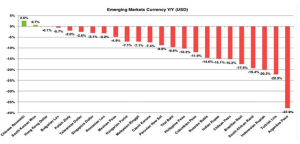Friday Thoughts
Stock market corrections…. With the S&P now down around 8% from last months all time highs (at time of writing), and other western stock markets making similar moves, we are currently somewhere between what we would call a ‘dip’ and a ‘correction’.
(See below table)
For what it’s worth, I have no idea whether this recent dip is the start of a new bear market or whether stocks are going to blast off to the moon again.
I do know though, that nobody else knows either.
Amongst all the inevitable hysterics of financial commentary, it is best to try not to play for either team – bulls or bears.

So, what to do during corrections?
I’d recommend keeping a list of high quality stocks you’ve been kicking yourself for missing out on and clear the decks of anything you currently own which you don’t truly love.
For those with time horizons of more than 5 years (most), the best thing to do is grit ones teeth and do very little.
If a correction of 15-20% is unbearbale, then you’ve either got too much money invested in stocks, or you’re a bit of a fairy.
Make the adjustment you can live with.
Nobody knows if the correction will become a bear market (or even worse, a crash), but this is always possible.
But, most corrections (as shown throughout history) do not become crashes, and every single one of them turned out to be great buying opportunities in the fullness of time.
Stay cool….
Emerging markets…. Time to have a dabble…?
I am increasingly thinking that this continued EM sell-off is offering up an opportunity for medium/long term investors.
It has been extremely difficult to find some distressed ‘value’ in equity markets of late, and this could be just that.
However, this has also been a good reminder of a few things to consider when investing in this asset class.
Firstly, there is going to be volatility in these markets, and this must be expected. It is unlikely to change for some time.
Secondly, it is important to note that despite often being mentioned in the same group, not all ’emerging markets’ are created equal.
Issues facing countries like Turkey and South Africa are not the same as ones facing the likes of China and South Korea. Despite the dour headlines, some markets are actually more reilient than they appear. For example, both China and South Korea are running current account surpluses and have large FX reserves, and so Fed tapering is likely to impact emerging markets differently.
Countries dependant on foreign funding, such as Turkey and S.A are likely to struggle in contrast to China and Korea. The chart below showing Y/Y currency changes outlines the difference.
Thirdly, it is also a truth that emerging markets offer deep value.
Given that they are growing faster than those in the developed world, they still look cheap by most metrics. Currently, EM equities are trading at about a 40% discount to developed country stocks, representing the largest discount since the financial crisis.
It shows us that it is impossible to time markets.
That said, some EM markets will soon start to look very attractive on a long term view, although not all equally attractive, and it is important to take a more discerning approach to the EM asset class.
The bottom line, if you want some exposure to the economic growth of the emerging markets, and are happy to allocate over the medium/long term and ride out the storm there is likely to be some selectively found value – now, if not soon.
Other bits of interest….
Twitter falls on weak user growth…..

